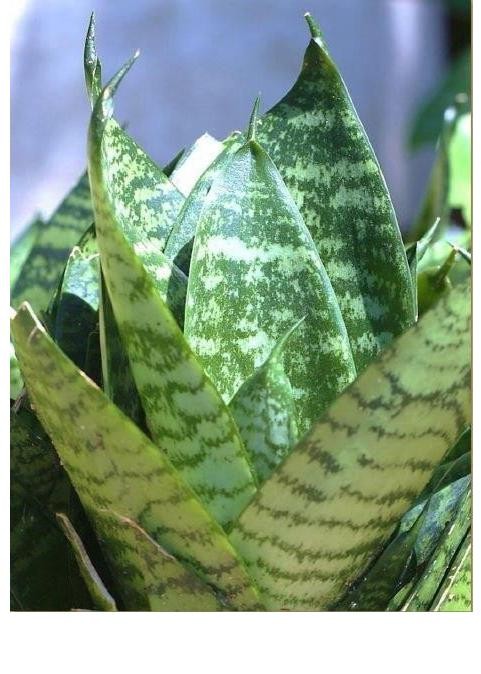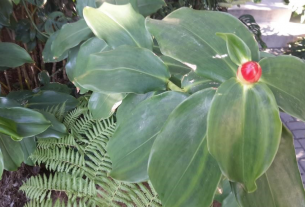By Tommy Clarkson from the January 2017 Edition
African Mask, Alocasia amazonica
Family: Araceae
Also known as: Amazon Elephant’s Ear, Green Velvet, Jewel Alocasia, Alocasia Alligator, Amazon Lily, 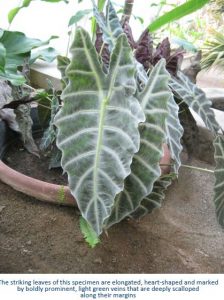 African Black Shield Plant, Alocasia Polly (or Poly) Hilo’s Beauty Elephant Ear and I know a Mexican gardener who calls them Vampire’s Ear!
African Black Shield Plant, Alocasia Polly (or Poly) Hilo’s Beauty Elephant Ear and I know a Mexican gardener who calls them Vampire’s Ear!
I have thought that this uniquely-dramatic tropical beauty, with its striking, two tone leaves, might better be named the “Alias Plant” as it is called by so many different names. And beyond that, there is no little debate about its creation exactly who hybridized it. But by most accounts it appears to be a hybrid of the Southeast Asian Alocasia longiloba and Alocasia sanderian and seems to have emerged in the public’s awareness in the 1950’s.
From here on I will endeavor to be a bit more exact such as the fact that we know this highly attractive plant is, in fact, a hybrid family member of the 78 species in the genus Alocasia which is comprised of broad-leaved rhizomatous or tuberous perennials perhaps best known for the Calla Lily and Jack in the pulpit.
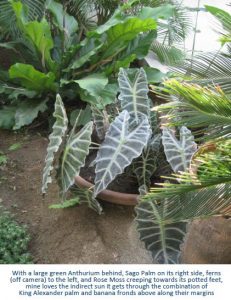
As a rule, its magnificent, arrow shaped leaves are 30.5 cm (12”) to 61 cm (24”) long and 15 cm (6”) to 30 cm (11″) wide. These generally reach a height of 61 cm (2’), though I’ve heard of them being but have not seen them myself between three and four feet tall.
These striking deep dark, roughly serrated, green through dark purple to nearly jet black heart-shaped, leaves are marked by boldly prominent, whitish or light green veins and are deeply scalloped along their margins.
These leaves are scalloped on the edges. Surrounding those primary lateral veins are very light colored zones and some clones have an intriguing network of silver veinlets that run between the primary lateral veins.
The underside is, more often than not, a matte purple in color. As a rule, each main trunk will only produce four to five leaves at a time and as a new leaf grows, it sheds an older one. Whichever of these compositions you may come across, rest assured that it is an attractive plant and will be a great addition to your garden family.
The greencolored petiole is around 38 cm (15”) with a dullish brown variegation in its lower half. The corms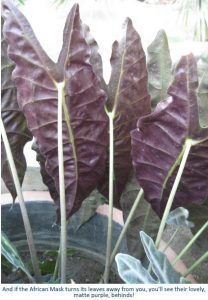 (short swollen underground stem base) are white with a tint of pale pink.
(short swollen underground stem base) are white with a tint of pale pink.
While appreciating high humidity (low humidity can cause leaf dieback), these guys like bright, indirect light, preferring about 60% shade. Does that sound a bit confusing? Well, simply re-member that they don’t like strong, direct sunlight. Another protective measure to take is that they need shelter from the wind.
As do most of the Alocosias, they have no small appreciation for agua. But allow the soil to dry slightly between waterings then give it a good, thorough drink. Ensure they are planted in well-draining – properly aerated, rich, potting soil. (That “well draining” part is worth repeating as too much standing moisture can cause crown rot. If you encounter a problem, chances are that this is the problem.)
If used as an indoor plant, keep an eye out for spider mites or scale if the plant is stressed. During the warmer summertime, feed once a month with a balanced, soluble plant food. And in order to have the best presentation, cut away dead and dying leaves and wipe the healthy, attractive ones off every now and again to enjoy the full majesty of their beauty.
By whatever name you decide to call them, they will make a wonderful addition to your garden.
Download the full edition or view it online
—
Tommy Clarkson is a bit of a renaissance man. He’s lived and worked in locales as disparate as the 1.2 square mile island of Kwajalein to war-torn Iraq, from aboard he and Patty’s boat berthed out of Sea Bright, NJ to Thailand, Germany, Hawaii and Viet Nam; He’s taught classes and courses on creative writing and mass communications from the elementary grades to graduate level; He’s spoken to a wide array of meetings, conferences and assemblages on topics as varied as Buddhism, strategic marketing and tropical plants; In the latter category he and Patty’s recently book, “The Civilized Jungle” – written for the lay gardener – has been heralded as “the best tropical plant book in the last ten years”; And, according to Trip Advisor, their spectacular tropical creation – Ola Brisa Gardens – is the “Number One Tour destination in Manzanillo”.



